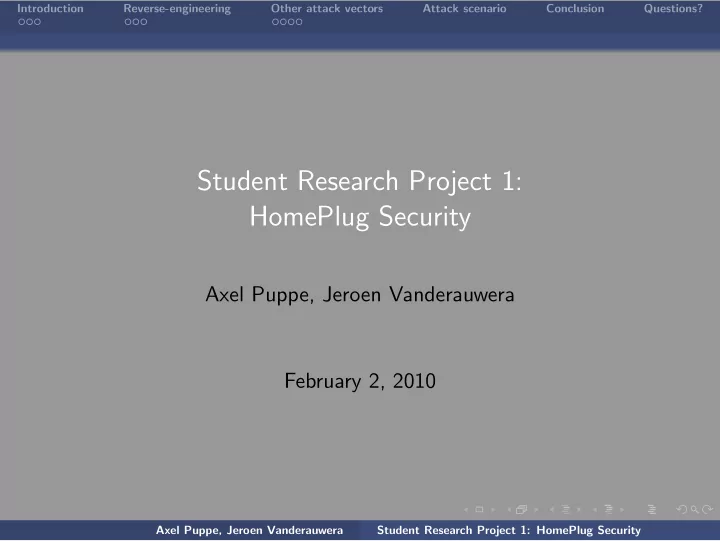

Introduction Reverse-engineering Other attack vectors Attack scenario Conclusion Questions? Student Research Project 1: HomePlug Security Axel Puppe, Jeroen Vanderauwera February 2, 2010 Axel Puppe, Jeroen Vanderauwera Student Research Project 1: HomePlug Security
Introduction Reverse-engineering Other attack vectors Attack scenario Conclusion Questions? Outline Introduction Homeplug technology Homeplug security Research question Reverse-engineering Firmware updater Firmware image Other attack vectors Brute force attack Dictionary attack Denial-of-service Attack scenario Conclusion Questions? Axel Puppe, Jeroen Vanderauwera Student Research Project 1: HomePlug Security
Introduction Reverse-engineering Other attack vectors Attack scenario Conclusion Questions? Homeplug technology How do the homeplugs work? ◮ Network over the power lines ◮ Traffic is broadcasted (200m range) ◮ Plug & Play due to default password ‘HomePlug’ Axel Puppe, Jeroen Vanderauwera Student Research Project 1: HomePlug Security
Introduction Reverse-engineering Other attack vectors Attack scenario Conclusion Questions? Homeplug security How are they secured? ◮ NEK defines logical network ◮ MD5(MD5(password + salt)) * 998 ◮ Salt: 0x08 0x85 0x6D 0xAF 0x7C 0xF5 0x81 0x85 ◮ Size: 8 bytes ◮ 56-bit DES encryption ◮ Security through obscurity Axel Puppe, Jeroen Vanderauwera Student Research Project 1: HomePlug Security
Introduction Reverse-engineering Other attack vectors Attack scenario Conclusion Questions? Research question Our research questions ◮ Can we reverse-engineer the homeplug firmware to enable promiscuous mode? ◮ If successful: Can we decrypt the encryption within a reasonable time frame with consumer hardware? ◮ If unsuccessful: Are there other attack vectors to join or disrupt a target homeplug network? Axel Puppe, Jeroen Vanderauwera Student Research Project 1: HomePlug Security
Introduction Reverse-engineering Other attack vectors Attack scenario Conclusion Questions? Firmware updater Before... Axel Puppe, Jeroen Vanderauwera Student Research Project 1: HomePlug Security
Introduction Reverse-engineering Other attack vectors Attack scenario Conclusion Questions? Firmware updater ...and after Axel Puppe, Jeroen Vanderauwera Student Research Project 1: HomePlug Security
Introduction Reverse-engineering Other attack vectors Attack scenario Conclusion Questions? Firmware image Attempts Firmware image: int5500cs-mac-firmware-zip.img Linux ‘file’ No known magic numbers Linux ‘mount’ No known file system Windows Daemon tools Could not mount it Windows Magic ISO Could not mount it Disassembling in IDA-Pro Failed to load it Looked for strings No plain text Testing randomness True random Scanning for magic numbers Only false positives Looked at other firmwares Did not help us understand the firmware image Atheros did not provide any information, unless we signed an NDA. Axel Puppe, Jeroen Vanderauwera Student Research Project 1: HomePlug Security
Introduction Reverse-engineering Other attack vectors Attack scenario Conclusion Questions? Brute force attack Scripting ◮ Bash: 5.8 keys per second ◮ Python/Scapy: 40 keys per second ◮ Python/Scapy optimised: 65 keys per second Axel Puppe, Jeroen Vanderauwera Student Research Project 1: HomePlug Security
Introduction Reverse-engineering Other attack vectors Attack scenario Conclusion Questions? Brute force attack Covering the entire 8 byte keyspace ◮ Size: 256 8 = 1 . 8 · 10 19 (18 billion billion!) ◮ Speed: 65 keys per second ◮ Time: 8 . 9 · 10 9 = 8.900.000.000 years ◮ Obviously not feasible... Axel Puppe, Jeroen Vanderauwera Student Research Project 1: HomePlug Security
Introduction Reverse-engineering Other attack vectors Attack scenario Conclusion Questions? Dictionary attack Alternative to bruteforce ◮ English dictionary: 80.000 words ◮ Speed: 65 keys per second ◮ Time required: 20 minutes ◮ Drawbacks: ◮ Success rate is not 100% ◮ Only works if people picked a weak password Axel Puppe, Jeroen Vanderauwera Student Research Project 1: HomePlug Security
Introduction Reverse-engineering Other attack vectors Attack scenario Conclusion Questions? Denial-of-service If we can’t hack it, can we break it? Yes we can! Without DoS DoS with DoS without correct NEK correct NEK Minimum 2ms 2ms 61ms Average 2ms 271ms 462ms Maximum 5ms 1184ms 1300ms Packetloss 0% 2% 30% Download speed 731KBps 3KBps 10Bps Axel Puppe, Jeroen Vanderauwera Student Research Project 1: HomePlug Security
Introduction Reverse-engineering Other attack vectors Attack scenario Conclusion Questions? Step-by-step plan 1. Reverse engineer the firmware updater 2. Set up the sniffing machine 3. Initiate denial-of-service attack 4. Hand over the malicious firmware to the victim 5. Terminate denial-of-service attack Axel Puppe, Jeroen Vanderauwera Student Research Project 1: HomePlug Security
Introduction Reverse-engineering Other attack vectors Attack scenario Conclusion Questions? And the results are... ◮ Can we reverse-engineer the homeplug firmware to enable promiscuous mode? No. ◮ If successful: Can we decrypt the encryption within a reasonable time frame with consumer hardware? No. ◮ If unsuccessful: Are there other attack vectors to join or disrupt a target homeplug network? Yes. ◮ Can we conclude that it’s safe? Axel Puppe, Jeroen Vanderauwera Student Research Project 1: HomePlug Security
Introduction Reverse-engineering Other attack vectors Attack scenario Conclusion Questions? And the results are... ◮ Can we reverse-engineer the homeplug firmware to enable promiscuous mode? No. ◮ If successful: Can we decrypt the encryption within a reasonable time frame with consumer hardware? No. ◮ If unsuccessful: Are there other attack vectors to join or disrupt a target homeplug network? Yes. ◮ Can we conclude that it’s safe? No! Axel Puppe, Jeroen Vanderauwera Student Research Project 1: HomePlug Security
Introduction Reverse-engineering Other attack vectors Attack scenario Conclusion Questions? Any questions? Axel Puppe, Jeroen Vanderauwera Student Research Project 1: HomePlug Security
Recommend
More recommend